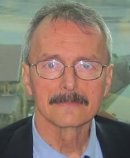
Plenary Lecture
The Information Maximization Principle in Molecular Modelling and Simulation

Professor Paul G. Mezey
Canada Research Chair in Scientific Modeling and Simulation
Department of Chemistry and Department of Physics and Physical Oceanography
Memorial University of Newfoundland
CANADA
E-mail: paul.mezey@gmail.com
Abstract: Modeling approaches typically involve some simplifications when compared to reality. A model is often restricted to some particular aspects of the real object or phenomenon it attempts to describe. Of course, the more information is available within a model, a more faithful description of reality can be obtained, however, classical modelling and simulation of two different properties of an object often require two different models.
However, modern quantum chemical molecular modelling and simulation approaches show a fundamentally different feature. A single model, the molecular wavefunction Ψ, is suitable to obtain information for several molecular properties, such as energy, stability, bonding geometry, shape, charge distribution, dipole moment, electrostatic potential, etc. Today, the computed approximate molecular wavefunctions Ψ are reliable enough to provide data on molecular properties, at an accuracy level competitive with experimental methods. Quantum mechanics has a special feature in this regard: since wavefunctions do represent the entire system under investigation, this provides opportunities for a rather different approach when compared to conventional, classical descriptions, where in the latter, we usually consider several different functions, where each one models and approximately describes only specific properties, instead all aspects of the object studied. On the one hand, a molecular wavefunction Ψ is indeed the complete representation of the molecule, and information about various molecular properties, such as energy, can be obtained by “questioning” this wavefunction Ψ, that is, by applying the Hamiltonian operator, the energy operator on this wavefunction. The same wavefunction Ψ can also be “questioned” about another property, such as the dipole moment, by applying a different operator on it. By contrast, in classical modelling, there is no representation of the entire, complete molecule by any single function, instead, various, individual molecular properties are described by various, individual functions. Quantum mechanical modelling always deals with a complete model, the molecular wavefunction, which, can be computed today to a sufficient level of accuracy. Hence, reliable quantum chemical modelling has a special advantage over classical modelling approaches: all intrinsic molecular properties are available within a single model.
Within the above general framework, this lecture will focus on a highly advantageous feature of quantum chemical molecular modelling, based on the Holographic Electron Density Theorem. This theorem, stated simply, ensures that even local ranges of accurate electron density clouds already contain the complete information about the entire molecule, the part “knows” everything about the whole. For actual, non-exact, but good quality local electron densities obtained within a given quantum chemical method, this theorem implies an Information Maximization Principle: if a local part of a molecule is modelled with the highest available accuracy, than the available information for the complete molecule is also maximized, implying a modelling approach for other parts of the molecule as well.
Brief Biography of the Speaker: Prof. Paul G. Mezey is the Canada Research Chair in Scientific Modeling and Simulation, Department of Chemistry, Memorial University, St. John’s, NL Canada.
For over twenty years, he is the Editor-in-Chief of the Journal of Mathematical Chemistry (Springer).
Prof. Mezey is Foreign Member of the Hungarian Academy of Sciences, and Full Member of the European Academy of Sciences, Arts, and Humanities, Paris.
He is also permanent Guest Professor at the University of Budapest, Hungary and the Babes-Bolyai University, Cluj, Romania.
His research fields are Molecular Informatics, Theoretical and Computational Chemistry, applied in molecular design, in medicine, and nanostructure research.
Prof. Mezey is author of over 420 scientific publications, two books, Potential Energy Hypersurfaces; Elsevier: Amsterdam, 1987, and Shape in Chemistry: An Introduction to Molecular Shape and Topology; VCH-Wiley: New York, 1993.
Dr. Mezey received most of his early education in Budapest, Hungary. As a child, he had to mature early in the 1956 Hungarian Revolution, later he became Hungarian Champion in the Junior Rowing-4 team.
His highest degrees are a PhD in Chemistry (U. Budapest, Hungary, 1972) and a DSc in Mathematics (U. Saskatchewan, Canada 1985).
Positions:
Scientific Associate, Peptide Chemistry Research Group, Hungarian Academy of Sciences (1969-73).
PDF at the University of Toronto, Canada and at the Centre de Mécanique Ondulatoire Appliquée, Paris, France (1973-76).
From 1977 he has been permanent faculty of the Department of Chemistry, University of Saskatchewan, Canada, from 1982 Full Professor. In 2003 he moved to take a Full Professor and a distinguished Canada Research Chair (Tier 1) position in Scientific Modelling and Simulation at the Memorial University, St. John’s, NL, Canada, continuing today.
He has served as Vice President of the World Association of Theoretical Organic Chemists, 1990-96, as Foreign Member, Institute of Fundamental Chemistry, Kyoto University, Japan, 1991-1998, as Secretary General of CODATA (International body for Data in Science, UNESCO/ICSU) Paris, 1998-2004, he received the Japan Society for Promotion of Science Award, 1987, and the Albert Szent-Györgyi Award of the Republic of Hungary, 2002, among other awards.
Main research achievements:
Mezey’s Holographic Electron Density Theorem is at the center of the new field of Molecular Informatics (each positive volume part of the electron density cloud contains the complete molecular information), this advance has received several international awards; his Fuzzy Molecular Fragment and Universal Molecule Models, his Molecular Similarity Measures, his Symmetry-Deficiency and Chirality Measures, and his ADMA macromolecular quantum chemistry method that provides linear-scaling, ab initio quality quantum chemistry results for proteins, applied in drug design and molecular engineering, are the most quoted.
He has given over 200 invited conference lectures in over 20 countries.